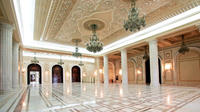5 Hour Communist Bucharest Private Tour
Bucharest, Romania
Trip Type: Cultural Tours
Duration: 5 hours
A private tour by car that will take you back in time to the dark communist age and show you Ceausescu’s vision of a communist Bucharest: from the identical grey apartment buildings to monumental boulevards and to the largest construction of them all – the Parliament Palace.
More About This Activity All Cultural Tours →
A private tour by car that will take you back in time to the dark communist age and show you Ceausescu’s vision of a communist Bucharest: from the identical grey apartment buildings to monumental boulevards and to the largest construction of them all – the Parliament Palace.
Over a quarter of a century has passed since the demise of communism and with it of its most prolific image: Nicolae Ceausescu. In spite of the tremendous growth the country and Bucharest have experienced during these years, the remnants of this regime are still noticeable in most aspects of everyday life: from the political class to public health care to the predominant urban architecture.
In the 24 years Ceausescu was in charge of the country, he managed to change the way both Romania and Bucharest looked so that it mirrored the principles of socialism as much as possible. This meant that many old buildings preceding the communist period were taken down and replaced by grey apartment blocks.
The earthquake of 1977 aided Ceausescu in his plan to reshape the city by causing great damage to hundreds of old buildings. But the greatest destruction of Bucharest took place in the 1980’s when a fifth of the city’s surface was demolished in order to make room for the new Civic Center, a project centred on the Palace of the Republic, today the Parliament Palace which you will visit on the tour.
Below you can find the main communist sights in Bucharest that you will see during this private tour:
The Palace of the Parliament is the second largest building in the world after the Pentagon and the most expensive administrative building. At the time when the Romanian people was subject to shortages of all kind, vast amounts of money, materials and work effort was poured into this construction site. The interiors impress through their size and luxury that features marble, crystal chandeliers, gold leaf details and some of the heaviest carpets and velvet curtains. From the top terrace of the Palace you will be able to fully fathom the vision that Ceausescu had for the city.
Behind the utilitarian building facades we will find small traces from the old Bucharest, such as Antim Monastery, which fortunately survived the demolition frenzy and are a testimony of a completely different city.
The Victory of Socialism Boulevard is the socialist version of the Champs Elysees from Paris.
The Spark House is the building holding all the major newspaper headquarters during communism – a time when the press was under the complete control of a dictator reaching down to control the everyday life of the regular citizen.
Ceausescu’s residence is an astounding contrast to the apartment buildings designated for the factory workers – thirty years ago you would have been arrested upon setting foot on his street.
Revolution Square is where the communist regime began and where it all ended with Ceausescu’s flight from the Central Committee building on December 22 during the Revolution of 1989.
In the 24 years Ceausescu was in charge of the country, he managed to change the way both Romania and Bucharest looked so that it mirrored the principles of socialism as much as possible. This meant that many old buildings preceding the communist period were taken down and replaced by grey apartment blocks.
The earthquake of 1977 aided Ceausescu in his plan to reshape the city by causing great damage to hundreds of old buildings. But the greatest destruction of Bucharest took place in the 1980’s when a fifth of the city’s surface was demolished in order to make room for the new Civic Center, a project centred on the Palace of the Republic, today the Parliament Palace which you will visit on the tour.
Below you can find the main communist sights in Bucharest that you will see during this private tour:
The Palace of the Parliament is the second largest building in the world after the Pentagon and the most expensive administrative building. At the time when the Romanian people was subject to shortages of all kind, vast amounts of money, materials and work effort was poured into this construction site. The interiors impress through their size and luxury that features marble, crystal chandeliers, gold leaf details and some of the heaviest carpets and velvet curtains. From the top terrace of the Palace you will be able to fully fathom the vision that Ceausescu had for the city.
Behind the utilitarian building facades we will find small traces from the old Bucharest, such as Antim Monastery, which fortunately survived the demolition frenzy and are a testimony of a completely different city.
The Victory of Socialism Boulevard is the socialist version of the Champs Elysees from Paris.
The Spark House is the building holding all the major newspaper headquarters during communism – a time when the press was under the complete control of a dictator reaching down to control the everyday life of the regular citizen.
Ceausescu’s residence is an astounding contrast to the apartment buildings designated for the factory workers – thirty years ago you would have been arrested upon setting foot on his street.
Revolution Square is where the communist regime began and where it all ended with Ceausescu’s flight from the Central Committee building on December 22 during the Revolution of 1989.
« Go Back

